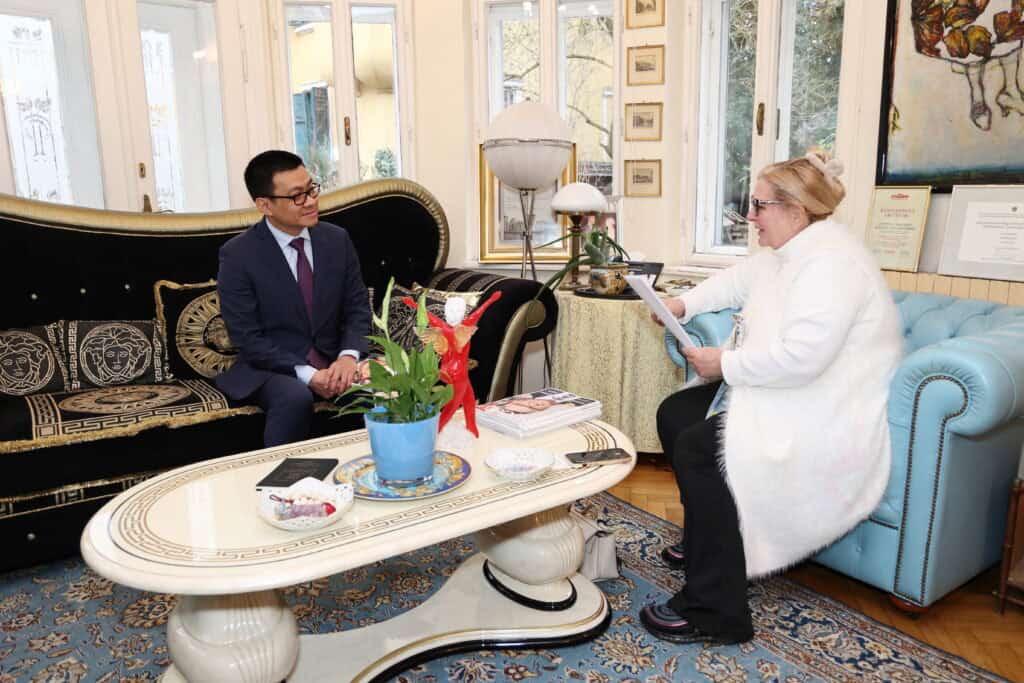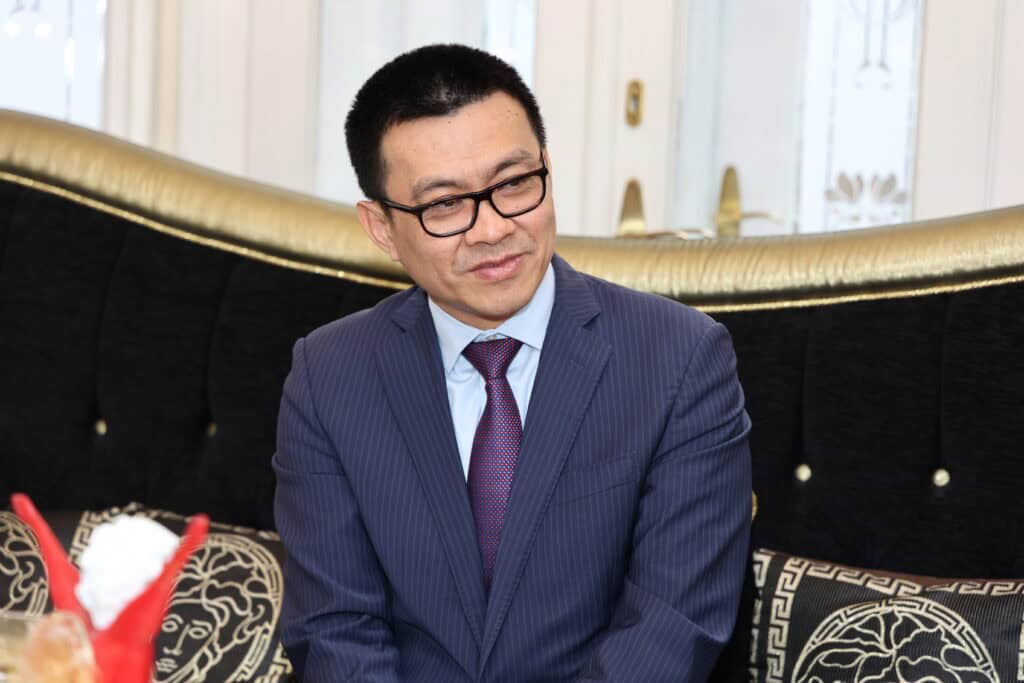Diplomatic SOCIETY met the Ambassador of Viet Nam to Austria, H.E. VU Le Thai Hoang, and talked with him about the history of Viet Nam-Austria relations, Viet Nam’s remarkable economic growth, its relations with the EU and how it plans to tackle climate change.
Viet Nam and Austria established diplomatic relations in 1972 – how did the ties develop since then?
The year 1972 is often cited as the official beginning of diplomatic relations, however, a closer look at the history reveals that the foundation for bilateral relations was already laid in 1869, when Austrian Emperor Franz Josef I issued a decree to establish an Honorary Consulate in Saigon, now Ho Chi Minh City.
In 1972, when Viet Nam’s struggle for independence and freedom reached its peak, Austria became the third Western nation to establish diplomatic relations with Viet Nam. The Vietnamese people still hold dear the memories of Austria’s support in rebuilding Viet Nam after the war.
Since the 1990s, bilateral relations have developed positively. Both countries maintain an active exchange of high-level delegations. They support each other in international forums and at the UN. Both nations pursue strategic autonomy and share a commitment to a rules-based international order, multilateral diplomacy, sustainable development, and tackling global challenges such as climate change.
Economic relations have gradually recovered to pre-COVID levels. Austrian companies benefit from Viet Nam’s dynamic market and its role as a manufacturing and logistics hub in Southeast Asia. Conversely, Vietnamese businesses are increasingly interested in Austria’s cutting-edge technologies in semiconductor, quantum, AI.
Austria is now among Viet Nam’s ten most important trade partners within the EU, while Viet Nam is Austria’s largest trading partner in Southeast Asia, with an annual trade volume of approximately $2.4 to $3 billion. One of the key objectives during my tenure is to further strengthen economic relations, with a particular focus on high technology, innovation, railway transportation, smart cities management, labour and vocational training, and tourism.
Cooperation extends beyond economics. Arts, music, and cultural heritage preservation are gaining increasing attention from both sides. Austria can also benefit from a valuable asset, which is the community of more than 100,000 Vietnamese in Viet Nam who have strong German language skills. This community serves as a bridge between Viet Nam and German-speaking countries.
Viet Nam has the highest number of agreements with the EU out of all Southeast Asian countries and it is considered to be a crucial partner for the bloc in the region – how does your country profit from this cooperation and vice versa?
Viet Nam and the EU established diplomatic relations in 1990. The relationship began with humanitarian aid addressing the consequences of the war in Viet Nam, followed by numerous programs supporting Viet Nam in policy planning and capacity building. The Viet Nam – EU relationship has been shaped by several agreements. Additionally, both sides have established various cooperation mechanisms. As a result, Viet Nam is one of the few Asian countries with such a comprehensive and in-depth cooperation framework with the EU.
The 5 year old Free Trade Agreement is a win-win deal for both parties. In less than five years, two-way economic relations have experienced rapid growth. In 2024, the trade balance reached $68.4 billion. The EU is now Viet Nam’s sixth-largest foreign direct investor (FDI), while Viet Nam has become the EU’s largest trading partner among ASEAN countries.
European investment in Viet Nam has also increased, with notable contributions from companies such as Lego ($1 billion), Bosch ($340 million), and BW Industrial ($100 million). Moreover, as an active ASEAN member, Viet Nam serves as a strategic gateway into the region.
At the 5th meeting of the Viet Nam – EU Joint Commission at the end of October 2024, the two sides agreed to work together to upgrade the partnership towards the celebration of the 35th anniversary of diplomatic relations in 2025.



You have acted as Dean of the Diplomatic Academy of Viet Nam – what are, in your opinion, the most important skills a diplomat has to master? And how did you prepare yourself for your post here in Austria?
In my view, the fundamental prerequisite for every civil servant and diplomat is love for one’s homeland, and this must be learned from childhood. Only when one loves their homeland will they be ready to serve it faithfully.
I have dedicated nearly 30 years to my diplomatic career in various roles. Originally, I worked as a lecturer and research fellow at the Diplomatic Academy of Vietnam (DAV), so analytical and strategic thinking is crucial, as I deal with complex international relations, and a diplomat must be able to understand and foresee political and economic trends.
I then became a policy officer in the Department of Foreign Policy Planning, and my experience as a lecturer and researcher has been immensely helpful. From now on, several foreign assignments were ahead. Negotiations and political discussions with international partners require negotiation skills. While theory is taught at the DAV, „practice makes perfect.“
A privilege of diplomats is to travel around the world and encounter many cultures and customs. However, the line between diplomatic success and disaster due to cultural differences is very thin. Therefore, intercultural adaptability and communication is essential.
And how can international relations work without network building? For me, all politics is personal. Personal contacts and trust-based relationships play a crucial role in this context.
It is a great honour for me to represent my homeland as Ambassador in Austria. To prepare for my tenure, I have delved deeply into Austria’s political and socio-economic situation. However, I am also fascinated by Austria’s history, music and culture, and the legend surrounding Empress Sisi continually captivates me.
Viet Nam’s economy is growing remarkably fast – what are the key enablers of this growth?
I can provide you with some impressive figures for the year 2024: GDP growth rate: 7.09%, economic size: 470 billion USD, economic freedom index: improved by 13 places to rank 59 out of 176 countries. Viet Nam is among the 15 leading developing countries with the highest foreign direct investment (FDI) worldwide, with a total volume of 40 billion USD, of which about 25 billion USD has already been realized. Viet Nam is among the 20 largest trading nations with 17 free trade agreements (FTA). The country is undergoing a dynamic transformation toward a digital, green, and technology-based economy. Particularly in the global semiconductor supply chains and AI, Viet Nam has gained a key position.
There are many factors contributing to these economic successes. I will highlight the most important ones: First, Viet Nam pursues an open trade policy. Our country is now part of many trade agreements (EVFTA, CPTPP, RCEP) that promote exports and investment. Second, Viet Nam offers an attractive investment climate for foreign companies with tax incentives, young labour forces, and a strategically favourable location. Third, there is massive investment in digital transformation, technology promotion, and start-ups. Fourth, the expansion of critical infrastructure projects significantly contributes to the country’s competitiveness and connectivity. Finally, the political stability and comprehensive reforms of the country ensure a business-friendly environment.
Viet Nam is one of the countries to be most affected by climate change – can you tell us a bit about your country’s climate change strategy?
You are right, Viet Nam is one of the countries most affected by climate change. One example: with a rise in sea levels by 1 meter, the Mekong Delta – the rice bowl of Viet Nam – is at risk of losing 20% of its area.
The Vietnamese government has implemented a national strategy against climate change until 2050. Its main goal is the international commitment to the Paris Agreement to become climate-neutral by 2050. This includes phasing out coal by 2045. Additionally, renewable energies such as solar and wind power are being promoted, along with climate adaptation strategies and protective measures regarding flood protection, coastal defense as well as sustainable urban development and electric mobility.
However, Viet Nam still faces significant challenges, particularly due to its economic dependence on coal and fossil fuels, as well as the high costs of adaptation measures.
Austria owns many green technologies and has valuable experience in environmental protection, renewable energy and urban development. It is my goal during my tenure as Ambassador to intensify cooperation and exchange of experiences in this field.

